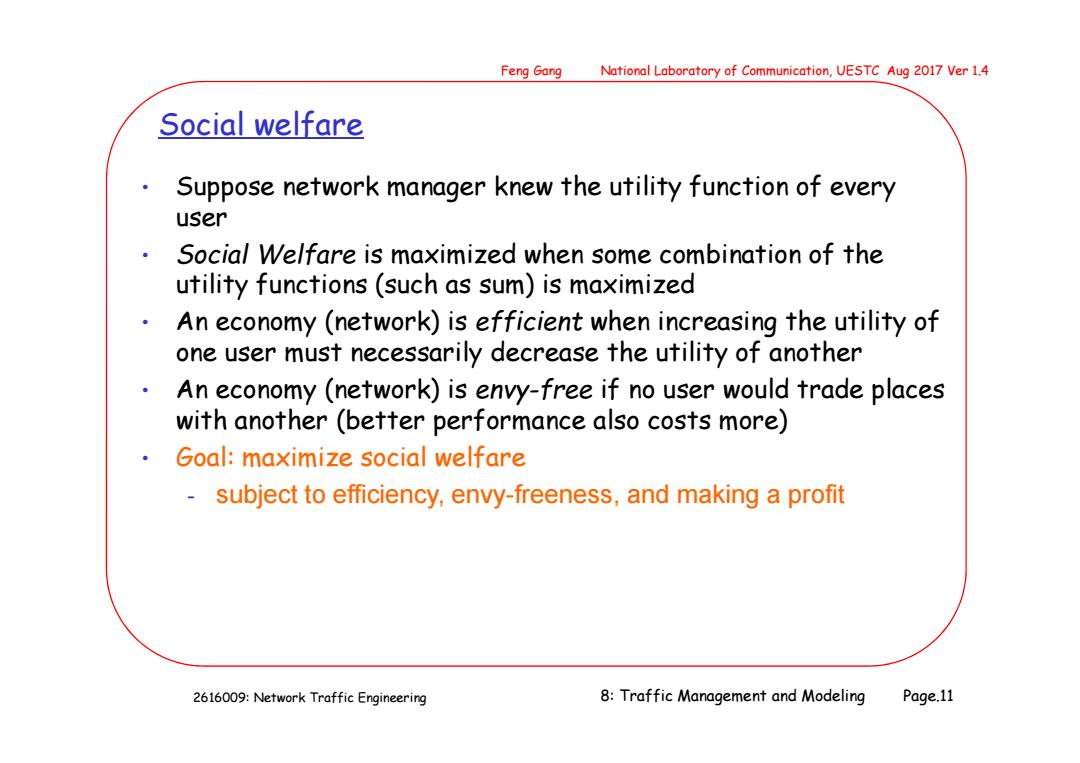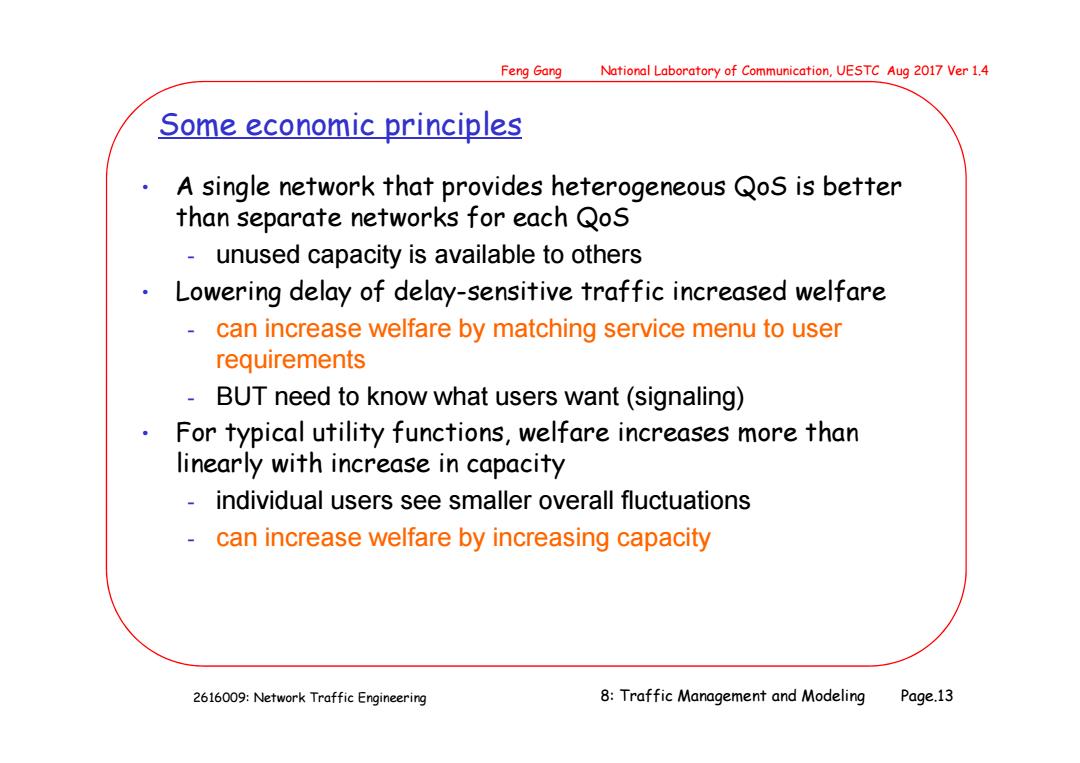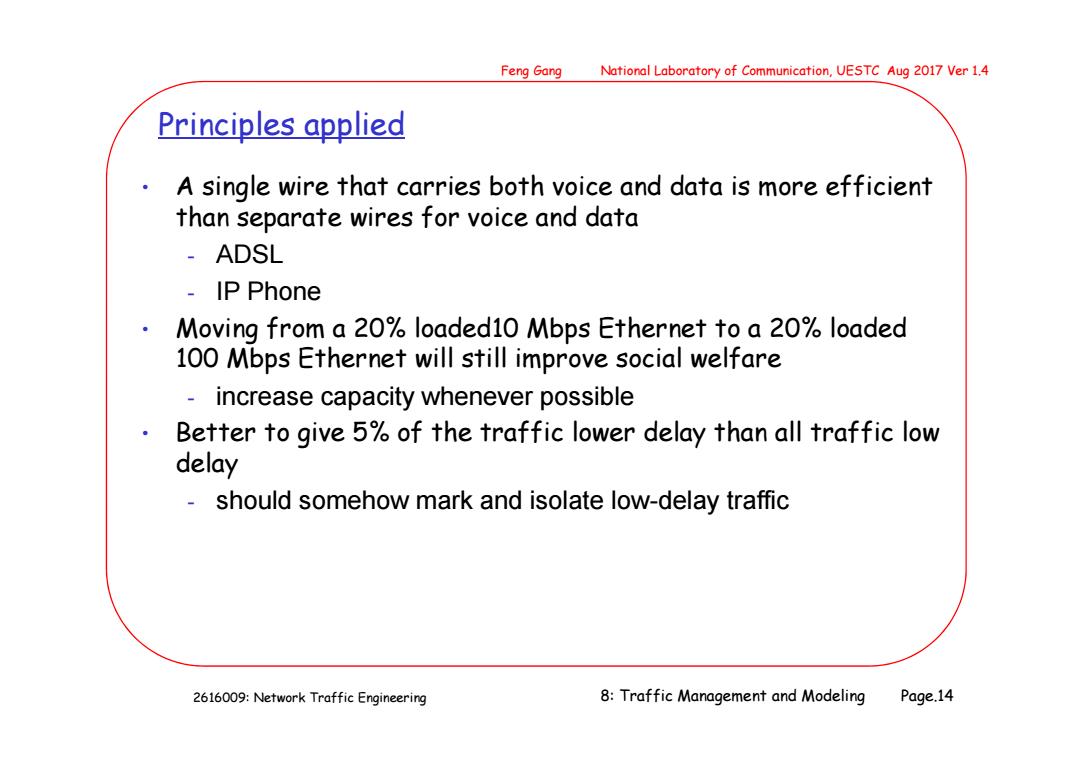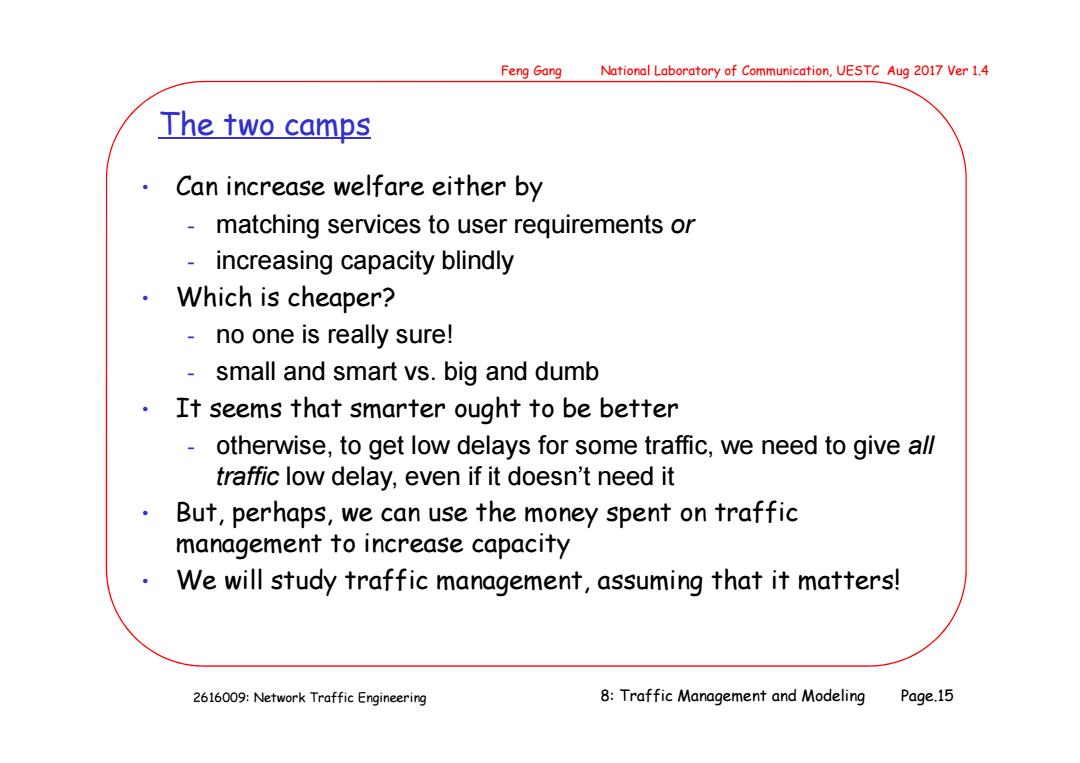
Feng Gang National Laboratory of Communication,UESTC Aug 2017 Ver 1.4 Social welfare Suppose network manager knew the utility function of every user 。 Social Welfare is maximized when some combination of the utility functions (such as sum)is maximized An economy (network)is efficient when increasing the utility of one user must necessarily decrease the utility of another An economy (network)is envy-free if no user would trade places with another (better performance also costs more) Goal:maximize social welfare subject to efficiency,envy-freeness,and making a profit 2616009:Network Traffic Engineering 8:Traffic Management and Modeling Page.11
2616009: Network Traffic Engineering Feng Gang National Laboratory of Communication, UESTC Aug 2017 Ver 1.4 8: Traffic Management and Modeling Page.11 Social welfare • Suppose network manager knew the utility function of every user • Social Welfare is maximized when some combination of the utility functions (such as sum) is maximized • An economy (network) is efficient when increasing the utility of one user must necessarily decrease the utility of another • An economy (network) is envy-free if no user would trade places with another (better performance also costs more) • Goal: maximize social welfare - subject to efficiency, envy-freeness, and making a profit

Feng Gang National Laboratory of Communication,UESTC Aug 2017 Ver 1.4 Example Assume Single switch,each user imposes load 0.4 A utility:4-d B utility 8-2d Same delay to both users ·Conservation law 0.4d +0.4d C=>d 1.25 C =sum of utilities 12-3.75 C If B delay reduced to 0.5C,then A delay 2C Sum of utilities 12-3C · Increase in social welfare need not benefit everyone A loses utility,but may pay less for service 2616009:Network Traffic Engineering 8:Traffic Management and Modeling Page.12
2616009: Network Traffic Engineering Feng Gang National Laboratory of Communication, UESTC Aug 2017 Ver 1.4 8: Traffic Management and Modeling Page.12 Example • Assume - Single switch, each user imposes load 0.4 - A utility: 4 - d - B utility : 8 - 2d - Same delay to both users • Conservation law - 0.4d + 0.4d = C => d = 1.25 C => sum of utilities = 12-3.75 C • If B delay reduced to 0.5C, then A delay = 2C - Sum of utilities = 12 - 3C • Increase in social welfare need not benefit everyone - A loses utility, but may pay less for service

Feng Gang National Laboratory of Communication,UESTC Aug 2017 Ver 1.4 Some economic principles A single network that provides heterogeneous QoS is better than separate networks for each QoS unused capacity is available to others 。 Lowering delay of delay-sensitive traffic increased welfare can increase welfare by matching service menu to user requirements BUT need to know what users want (signaling) 。 For typical utility functions,welfare increases more than linearly with increase in capacity individual users see smaller overall fluctuations can increase welfare by increasing capacity 2616009:Network Traffic Engineering 8:Traffic Management and Modeling Page.13
2616009: Network Traffic Engineering Feng Gang National Laboratory of Communication, UESTC Aug 2017 Ver 1.4 8: Traffic Management and Modeling Page.13 Some economic principles • A single network that provides heterogeneous QoS is better than separate networks for each QoS - unused capacity is available to others • Lowering delay of delay-sensitive traffic increased welfare - can increase welfare by matching service menu to user requirements - BUT need to know what users want (signaling) • For typical utility functions, welfare increases more than linearly with increase in capacity - individual users see smaller overall fluctuations - can increase welfare by increasing capacity

Feng Gang National Laboratory of Communication,UESTC Aug 2017 Ver 1.4 Principles applied A single wire that carries both voice and data is more efficient than separate wires for voice and data ADSL IP Phone Moving from a 20%loaded10 Mbps Ethernet to a 20%loaded 100 Mbps Ethernet will still improve social welfare increase capacity whenever possible Better to give 5%of the traffic lower delay than all traffic low delay should somehow mark and isolate low-delay traffic 2616009:Network Traffic Engineering 8:Traffic Management and Modeling Page.14
2616009: Network Traffic Engineering Feng Gang National Laboratory of Communication, UESTC Aug 2017 Ver 1.4 8: Traffic Management and Modeling Page.14 Principles applied • A single wire that carries both voice and data is more efficient than separate wires for voice and data - ADSL - IP Phone • Moving from a 20% loaded10 Mbps Ethernet to a 20% loaded 100 Mbps Ethernet will still improve social welfare - increase capacity whenever possible • Better to give 5% of the traffic lower delay than all traffic low delay - should somehow mark and isolate low-delay traffic

Feng Gang National Laboratory of Communication,UESTC Aug 2017 Ver 1.4 The two camps Can increase welfare either by matching services to user requirements or increasing capacity blindly ·Which is cheaper? -no one is really sure! - small and smart vs.big and dumb 。 It seems that smarter ought to be better otherwise,to get low delays for some traffic,we need to give all traffic low delay,even if it doesn't need it But,perhaps,we can use the money spent on traffic management to increase capacity We will study traffic management,assuming that it matters! 2616009:Network Traffic Engineering 8:Traffic Management and Modeling Page.15
2616009: Network Traffic Engineering Feng Gang National Laboratory of Communication, UESTC Aug 2017 Ver 1.4 8: Traffic Management and Modeling Page.15 The two camps • Can increase welfare either by - matching services to user requirements or - increasing capacity blindly • Which is cheaper? - no one is really sure! - small and smart vs. big and dumb • It seems that smarter ought to be better - otherwise, to get low delays for some traffic, we need to give all traffic low delay, even if it doesn’t need it • But, perhaps, we can use the money spent on traffic management to increase capacity • We will study traffic management, assuming that it matters!